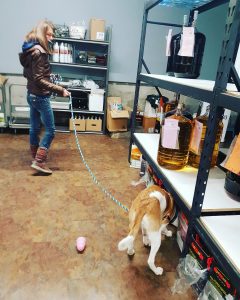
Guest post by Kate Rehman of K9 Triumph Training
I am disabled young lady who has a service dog to mitigate my disabilities in my every day life. I do tons of charity volunteer training sessions which are private one on one with rescues, pets, fosters and service dogs.
When you at me, you won’t see my disabilities; they’re invisible. Rest assured they do exist. I am Deaf; a rare genetic disease is to blame, amongst other disabling issues. I do not hear at all. My service dog alerts me for fire alarms, knocking, my name, dropped items that hit the floor, and other sounds that I might not notice.

I have had the pleasure of implementing Grisha’s BAT techniques/protocols with service dogs.
 By law, service animals must be under control when working. That means we have to figure out ways to reestablish training, and ‘empowered partnership’ means we do it in a way that also meets the dogs’ emotional needs.
By law, service animals must be under control when working. That means we have to figure out ways to reestablish training, and ‘empowered partnership’ means we do it in a way that also meets the dogs’ emotional needs.
 I go through the handler’s stance by gliding my hands over their shoulders (with permission). I go over their arms, their wrists and hands. I tell them what their body is showing, their energy, and what I see with their body language. Dogs responds to this.
I go through the handler’s stance by gliding my hands over their shoulders (with permission). I go over their arms, their wrists and hands. I tell them what their body is showing, their energy, and what I see with their body language. Dogs responds to this.
When we walk I watch the handler and how they walk. I stop them, ask questions and get in their minds/what they are feeling?
 My questions are, ‘Are you in the moment?‘ and ‘Can you look at how you holding the leash?’ I slide my hands gently down the leash and pull a tad (this is where you are creating tension). I remind them, ‘Remember to be in the moment with your partner.’
My questions are, ‘Are you in the moment?‘ and ‘Can you look at how you holding the leash?’ I slide my hands gently down the leash and pull a tad (this is where you are creating tension). I remind them, ‘Remember to be in the moment with your partner.’
 [Grisha’s note – touching the client can be distracting or it can be really useful. Please use your best judgement when working with clients and always get their consent, verbally and by observing their body language! Just as with the dogs, we need to respect their boundaries.]
[Grisha’s note – touching the client can be distracting or it can be really useful. Please use your best judgement when working with clients and always get their consent, verbally and by observing their body language! Just as with the dogs, we need to respect their boundaries.]
 Usually the handlers are almost paranoid, edgy and worried about judgement when we start; trying to correct their dog every move they make.
Usually the handlers are almost paranoid, edgy and worried about judgement when we start; trying to correct their dog every move they make.

 It takes no time for them to figure out and we have communicated clearly what we would like.
It takes no time for them to figure out and we have communicated clearly what we would like.
 No fighting, no pulling back and no frustration.
No fighting, no pulling back and no frustration.
 Even though some don’t have fearful or aggressive issues, the BAT leash protocols work excellent for unwanted behaviors and habits that have formed.
Even though some don’t have fearful or aggressive issues, the BAT leash protocols work excellent for unwanted behaviors and habits that have formed.
 We need to give respect and empathy to these amazing working dogs. BAT is one great way to help these dogs, whether it’s maintenance BAT leash protocols or BAT aggressive and fearful adjustment training.
We need to give respect and empathy to these amazing working dogs. BAT is one great way to help these dogs, whether it’s maintenance BAT leash protocols or BAT aggressive and fearful adjustment training.
Things happen on the job, but there is a solution, and if handlers are willing to find a professional trainer that does BAT things could definitely turn around for all.
Related article: BAT = BRILLIANT + AWESOME + TREMENDOUS! about using BAT to train assistance dogs in Canada